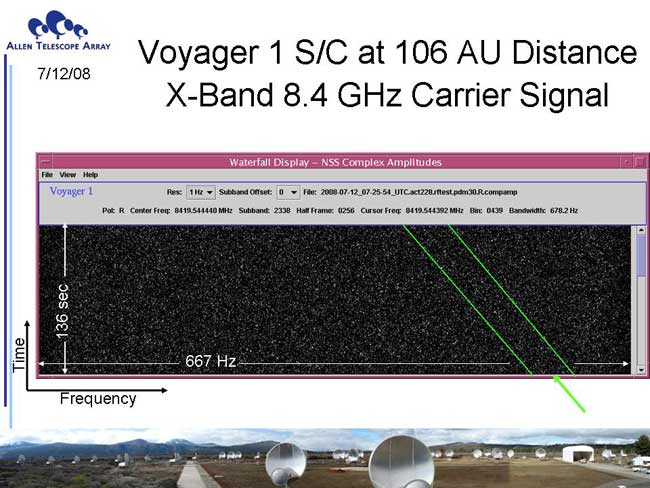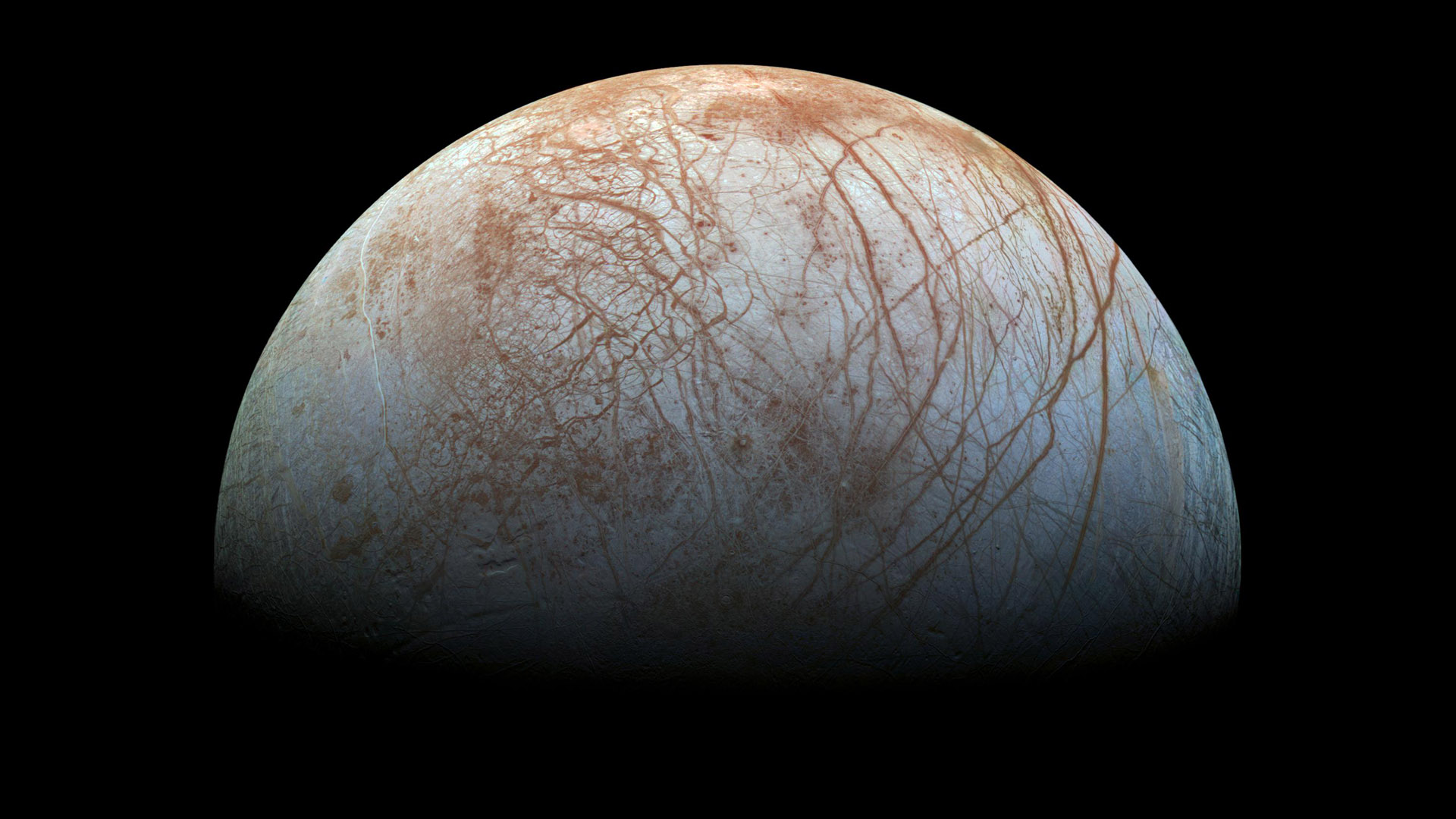SETI Signal Detectors on the Allen Telescope Array: First Light, Faint Fiducials

Jane Jordanruns the software team at the Center for SETI Research.? She is an avidbirdwatcher who displays lists of the birds she has been able to observe in theBay Area and around the world.
In thecubicle down the hall, where we conduct remote observations with our SETIdetectors installed on the Allen Telescope Array (ATA) at the Hat Creek Radio Observatory in NorthernCalifornia, Tom Kilsdonk has been keeping another list of ?birds? for the pastfew months. Tom?s list contains the distant spacecraft whose signals he hasbeen able to detect with our new/old Prelude detection systemworking in concert with the beamformers built by our consultant Billy Barott,along with Oren Milgrome, Matt Dexter, Dave MacMahon, and others from the RadioAstronomy Lab at UC Berkley.
This listof ?scored? satellites is part of the changeover from our old observingprograms, using two widely separated, large single-dish antennas as apseudo-interferometer during Project Phoenix, to a new set of strategies usingthe real deal i.e.many small antennas linked together interferometrically tomake up the ATA-42. It?s a small cubicle, but both days and nights, it?s fullof people like Peter Backus (our Observing Projects Manager) and Gerry Harp(our resident astrophysicist, who has also written much of the code thatcommands the array) who assist Tom, and cheer with excitement and pride as anew check mark goes on the list to signify another captured ?bird?.
Over theyears, our near-real time Project Phoenix SETI observationshave routinely used some of these spacecraft to verify the correct operation ofall our hardware and software detectors. Until NASA stopped transmitting to thedistant Pioneer 10spacecraft shortly after its 30th birthday in 2004, wechecked in on its transmitter every day.
Twiceduring our decade-long Project Phoenix exploration, Pioneer 10 didn?t show up -on one occasion the clock at our remote telescope in Australia had mysteriouslygained 21 seconds of time, and later the equipment at another remote site inthe UK became ?electron-challenged? when someone accidentally disconnected thepower cord. When Pioneer 10retired, we finished Project Phoenix with the help of the SETI Leagueand east coast radio amateurs who bounced signals off the Moon for us to find.
As we beginour SETI observing projects on the ATA, we face new challenges and even moreneed for these fiducials on the sky. We no longer have large single dishes asour collectors for the radio signals (for lots of really good reasons).
So insteadof big pieces of aluminum focusing the incoming radio waves onto a detector, wemust first electronically combine the signals (introducing time delays andphase shifts) from all the individual antennas in just the right way to pointthe ATA at a specific star before we send those signals to our detectors. Thisis done electronically with a beamformer.
Breaking space news, the latest updates on rocket launches, skywatching events and more!
One of thegood things about the ATA is that there are likely to be many stars that arevisible at any one time within its large field of view, so with multiplebeamformers, and multiple detectors, we can explore multiple starssimultaneously, at different frequencies if we want. Furthermore, we can dothis while our astronomy colleagues are mapping the sky for hydrogen gas, orlarge biogenic molecules, or other phenomena of scientific interest to them. Thismultiplexing potential is a new and exciting innovation that will speed up theSETI searching in the next decades.
Whilebeamforming may sound easy, it?s difficult in detail. It?s necessary tocalibrate all the required phase and time delays using astronomical sourceslike quasars, to keep all the signals aligned to a part in 1011(since we are now searching for ETI signals and DXing these distantspacecraft at higher X-band frequencies [8 GHz] in addition to L and S-band). It?salso necessary to completely remove the Walsh functions that are introduced tomodulate the individual antenna voltages, all before the SETI detectors canbegin their job.? Our beamformers are built out of FPGA-based modules developedby the BerkeleyWireless Research Center and the CASPER efforts at UC Berkeley.
On July 12,2008 the first beamformer combined 12 antennas together, and SETI Preludesystem detected the faint carrier signal from the Voyager 1spacecraft, that has recently passed through the termination shockin the solar wind to move beyond the edge of our solar system. This is the mostdistant man-made object - the signal we detected was transmitted from adistance of 106 AU (106 times the average distance of the Earth from the Sun)or 9.85 billion miles. Figure 1 shows the detected signal in a ?waterfall plot?of time vs. frequency.
Although itappears very faint to the human eye, the SETI Prelude detector integrated allthe power along the track of the signal and made a reliable detection with a veryhigh signal to noise ratio. On October 16, 2008 our beamformer testing hadadded another three antennas from the array, and even though the Voyager 1spacecraft had moved another 2 AU farther away, to top the 10 billion milemark, the detected signal in Figure 2 is more discernible to the naked eye -just think how easy it will be to find with all 42 antennas at work!? If youare still not convinced that the signal is there, take a look at Figure 3,which shows the results of integrating the power from the spacecraft carrierover the ~3 minute observation.
In additionto forming beams on particular stars in the sky, beamformers can also formnulls in other directions at the same time. Peter Backus and Gerry Harp are nowexercising this null capability to design observing strategies that are leastlikely to be fooled by interference from terrestrial technologies that findtheir way into the side-lobes of the array (like your eyes, radio telescopeshave a kind of peripheral vision).
During ourrecent testing, Ken Smolek, who consults for the Center for SETI Research fromhis home in Oregon, has also been on the phone with the folks in our observingcubicle. Ken is helping to build the next generation of SETI signal detectorcalled SonATA (SETI on theATA) to replace the Prelude detectors. SonATA does everything that Preludedoes, but it is a software-only detector, capable of operating on commodityservers, without the special-purpose hardware accelerators that had to be builtinto Prelude to make it run in near-real time.?
A demonstrationversion of SonATA has now reached its own milestone.
On October9, 2008 the X-band signal from the Rosettaspacecraft was detected by the SonATA demo system!? Figure 4 showsthat detection. The Rosetta X-band signal is much stronger than the signalsfrom Voyager 1, because it is only a few AU away, having recently flown-by asteroidSteins on its way to rendezvous with comet67P/Churyumov-Gerasimenko in 2014.
SonATA willbe one of the first software clients to operate on a new platform beingdeveloped at the SETI Institute with the help of private donors - a Software-DefinedRadio Telescope (SDRT). The SDRT is amulti-year project to develop, operate and support SETI observations for asimple, open and scalable, software-centric digital processing back-end for theAllen Telescope Array (ATA). The SDRT goals are to:
- Sustain exploitation of exponential "Moore's Law" improvements in commodity microprocessors, programmable logic, memory, storage and networking.
- Encourage new waves of innovation through software on general-purpose systems and by opening up the instrument and its simulacrum to a much wider community of users.
- Support the SETI Institute mission for full-time observing and detection of radio signals from extraterrestrials.
- Video - Reflections on Fermi's Paradox
- How I Spent My SETI Summer
- Video - Listening for Life
Join our Space Forums to keep talking space on the latest missions, night sky and more! And if you have a news tip, correction or comment, let us know at: community@space.com.
